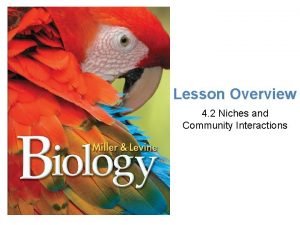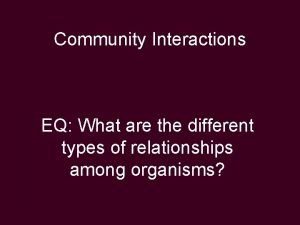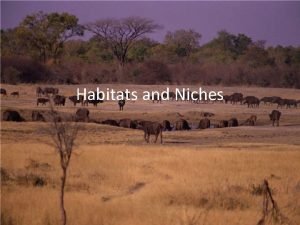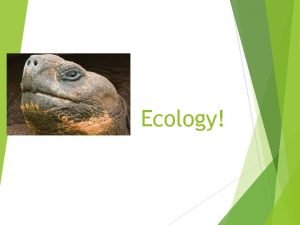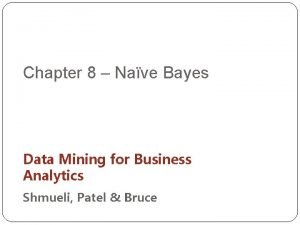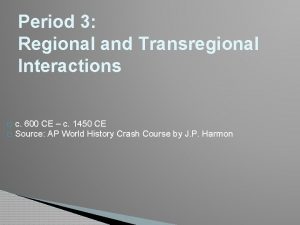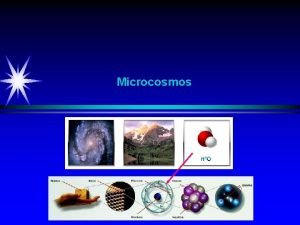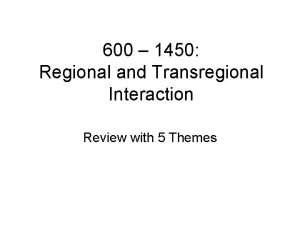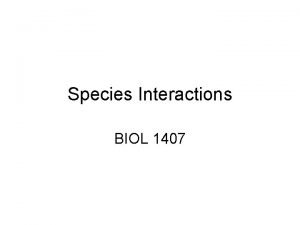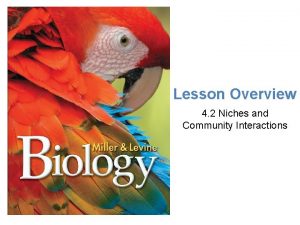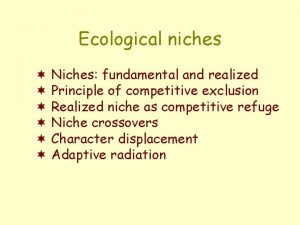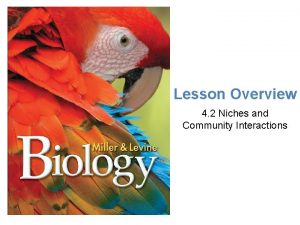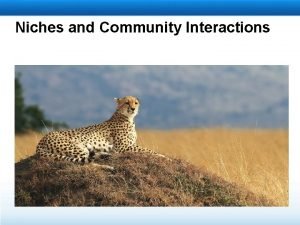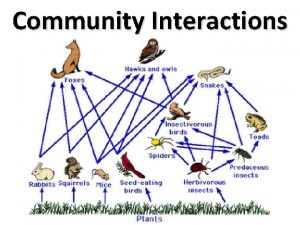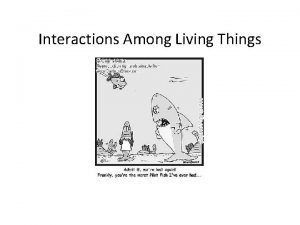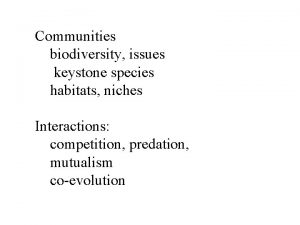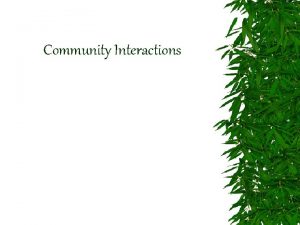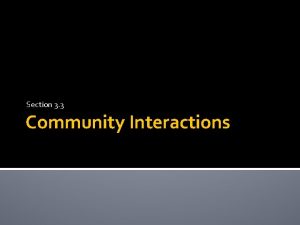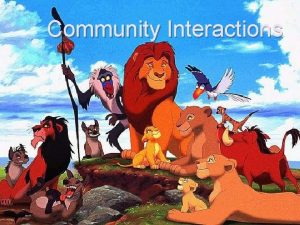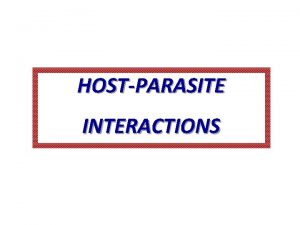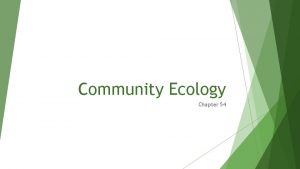Lesson Overview Niches and Community Interactions Lesson Overview
























- Slides: 24

Lesson Overview Niches and Community Interactions Lesson Overview 4. 2 Niches and Community Interactions

Lesson Overview The Niche What is a niche? Niches and Community Interactions

Lesson Overview Niches and Community Interactions The Niche What is a niche? A niche is the range of physical and biological conditions in which a species lives and the way the species obtains what it needs to survive and reproduce.

Lesson Overview Niches and Community Interactions Tolerance Every species has its own range of tolerance, the ability to survive and reproduce under a range of environmental circumstances.

Lesson Overview Niches and Community Interactions Tolerance When an environmental condition, such as temperature, extends in either direction beyond an organism’s optimum range, the organism experiences stress. The organism must expend more energy to maintain homeostasis, and so has less energy left for growth and reproduction.

Lesson Overview Niches and Community Interactions Tolerance Organisms have an upper and lower limit of tolerance for every environmental factor. Beyond those limits, the organism cannot survive. A species’ tolerance for environmental conditions, then, helps determine its habitat—the general place where an organism lives.

Lesson Overview Niches and Community Interactions Resources and the Niche The term resource can refer to any necessity of life, such as water, nutrients, light, food, or space. For plants, resources can include sunlight, water, and soil nutrients. For animals, resources can include nesting space, shelter, types of food, and places to feed.

Lesson Overview Niches and Community Interactions Physical Aspects of the Niche Part of an organism’s niche involves the abiotic factors it requires for survival. Most amphibians, for example, lose and absorb water through their skin, so they must live in moist places. If an area is too hot and dry, or too cold for too long, most amphibians cannot survive.

Lesson Overview Niches and Community Interactions Biological Aspects of the Niche Biological aspects of an organism’s niche involve the biotic factors it requires for survival, such as when and how it reproduces, the food it eats, and the way in which it obtains that food. Birds on Christmas Island in the Indian Ocean, for example, all live in the same habitat but they prey on fish of different sizes and feed in different places. Thus, each species occupies a distinct niche.

Lesson Overview Niches and Community Interactions Competition How does competition shape communities? By causing species to divide resources, competition helps determine the number and kinds of species in a community and the niche each species occupies.

Lesson Overview Niches and Community Interactions Competition How one organism interacts with other organisms is an important part of defining its niche. Competition occurs when organisms attempt to use the same limited ecological resource in the same place at the same time. Competition can occur both between members of the same species (known as intraspecific competition) and between members of different species (known as interspecific competition).

Lesson Overview Niches and Community Interactions The Competitive Exclusion Principle The competitive exclusion principle states that no two species can occupy exactly the same niche in exactly the same habitat at exactly the same time. If two species attempt to occupy the same niche, one species will be better at competing for limited resources and will eventually exclude the other species. As a result of competitive exclusion, natural communities rarely have niches that overlap significantly.

Lesson Overview Niches and Community Interactions Dividing Resources Instead of competing for similar resources, species usually divide them. This is known as resource partitioning. For example, the three species of North American warblers shown all live in the same trees and feed on insects. But one species feeds on high branches; another feeds on low branches, and another feeds in the middle.

Lesson Overview Niches and Community Interactions Predation, Herbivory, and Keystone Species How do predation and herbivory shape communities?

Lesson Overview Niches and Community Interactions Predation, Herbivory, and Keystone Species How do predation and herbivory shape communities? Predators can affect the size of prey populations in a community and determine the places prey can live and feed. Herbivores can affect both the size and distribution of plant populations in a community and determine the places that certain plants can survive and grow.

Lesson Overview Niches and Community Interactions Predator-Prey Relationships An interaction in which one animal (the predator) captures and feeds on another animal (the prey) is called predation. Birds of prey, for example, can play an important role in regulating the population sizes of mice, voles, and other small mammals.

Lesson Overview Niches and Community Interactions Herbivore-Plant Relationships An interaction in which one animal (the herbivore) feeds on producers (such as plants) is called herbivory. For example, very dense populations of white-tailed deer are eliminating their favorite food plants from many places across the United States. Predator-prey relationships and herbivory are key in maintaining balance between populations in an ecosystem.

Lesson Overview Niches and Community Interactions Keystone Species Sometimes changes in the population of a single species, often called a keystone species, can cause dramatic changes in the structure of a community. A keystone species is essential in maintaining the overall balance in a community. In the cold waters off the Pacific coast of North America, for example, sea otters devour large quantities of sea urchins. Urchins are herbivores whose favorite food is kelp, giant algae that grow in undersea “forests. ”

Lesson Overview Niches and Community Interactions Keystone Species A century ago, sea otters were nearly eliminated by hunting. Unexpectedly, the kelp forest nearly vanished. Without otters as predators, the sea urchin population skyrocketed, and armies of urchins devoured kelp down to bare rock. Without kelp to provide habitat, many other animals, including seabirds, disappeared. Otters were a keystone species in this community. After otters were protected as an endangered species, their population began to recover. As otters returned, the urchin populations dropped, and kelp forests began to thrive again.

Lesson Overview Niches and Community Interactions Symbioses Any relationship in which two species live closely together is called symbiosis, which means “living together. ” The three main classes of symbiotic relationships in nature are mutualism, commensalism, and parasitism.

Lesson Overview Niches and Community Interactions Mutualism The kind of relationship between species in which both benefit is known as mutualism. Mutualism is therefore a positive symbiosis. The sea anemone’s sting has two functions: to capture prey and to protect the anemone from predators. Even so, certain fish manage to snack on anemone tentacles. The clownfish, however, is immune to anemone stings. When threatened by a predator, clownfish seek shelter by snuggling deep into an anemone’s tentacles. If an anemone-eating species tries to attack the anemone, the clownfish dart out and chase away the predators.

Lesson Overview Niches and Community Interactions Commensalism The kind of relationship between species in which one organism benefits and the other is neither harmed nor helped is known as commensalism. Commensalism is therefore a positive symbiosis. Barnacles often attach themselves to a whale’s skin. They perform no known service to the whale, nor do they harm it. Yet the barnacles benefit from the constant movement of water—that is full of food particles—past the swimming whale. This is an example of commensalism, a relationship in which one organism benefits and the other is neither helped nor harmed.

Lesson Overview Niches and Community Interactions Parasitism The kind of relationship between species in which one organism benefits (the parasite) and the other organism is harmed (the host) is known as parasitism. Parasitism is therefore a negative symbiosis. Tapeworms live in the intestines of mammals, where they absorb large amounts of their hosts’ food. Fleas, ticks, lice, and the leech shown, live on the bodies of mammals and feed on their blood and skin. These are examples of parasitism, relationships in which one organism lives inside or on another organism and harms it.

Lesson Overview Niches and Community Interactions Parasitism The parasite obtains all or part of its nutritional needs from the host organism. Generally, parasites weaken but do not kill their host, which is usually larger than the parasite.
 Chapter 6 lesson 1 habitats niches and species interactions
Chapter 6 lesson 1 habitats niches and species interactions Niches and community interactions
Niches and community interactions 3 types of community interactions
3 types of community interactions Habitats and niches
Habitats and niches Tourism niches
Tourism niches La ligne faitiere des cretes
La ligne faitiere des cretes Zones de schroeder
Zones de schroeder Accounting information system chapter 1
Accounting information system chapter 1 Quantitative vs qualitative
Quantitative vs qualitative Contractionary fiscal policy interest rate
Contractionary fiscal policy interest rate The properties and interactions of magnets are called
The properties and interactions of magnets are called Geosphere and biosphere interactions
Geosphere and biosphere interactions Product architecture design
Product architecture design Factors affecting communication
Factors affecting communication Symbiosis and species interactions keystone webquest
Symbiosis and species interactions keystone webquest Naive bayes pays attention to complex interactions and
Naive bayes pays attention to complex interactions and Modular vs integral product architecture example
Modular vs integral product architecture example Regional and transregional interactions
Regional and transregional interactions Neutrinous
Neutrinous Regional and transregional interactions
Regional and transregional interactions Noncovalent interactions
Noncovalent interactions Interactions among branches of government
Interactions among branches of government Adelphoparasitism
Adelphoparasitism Parasitism pictures
Parasitism pictures Sertraline interactions
Sertraline interactions

